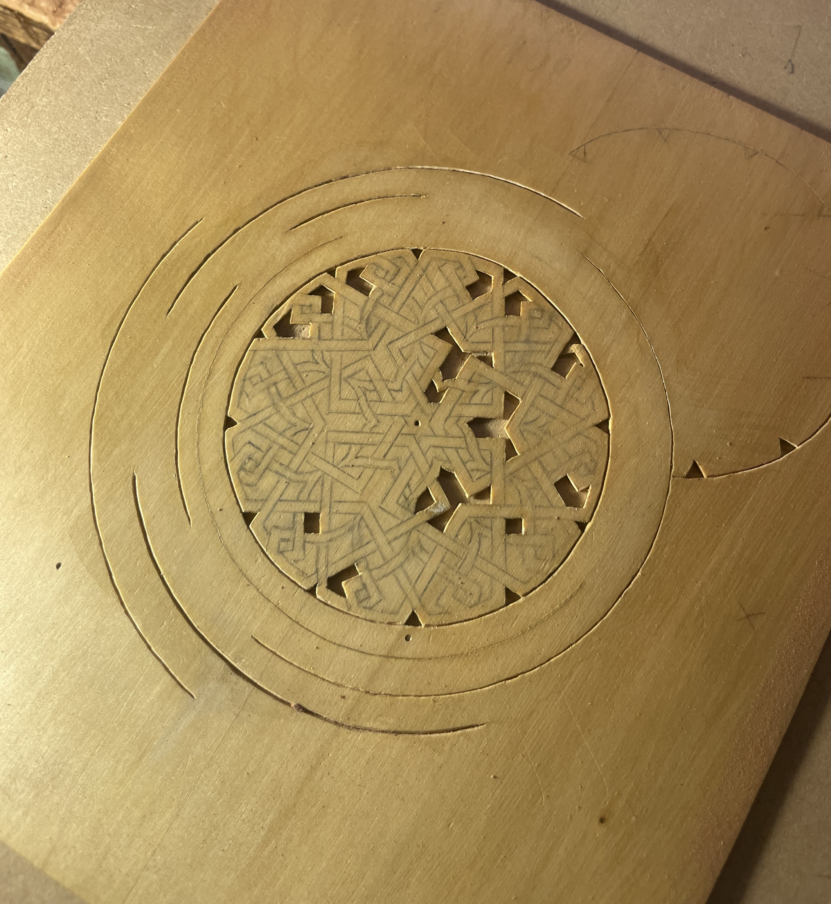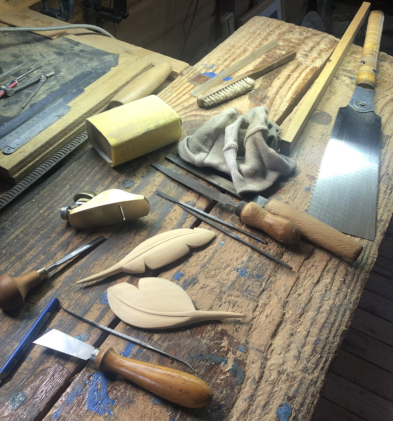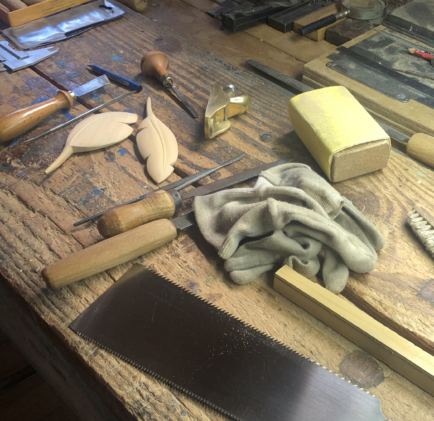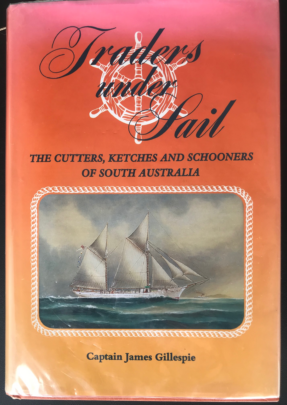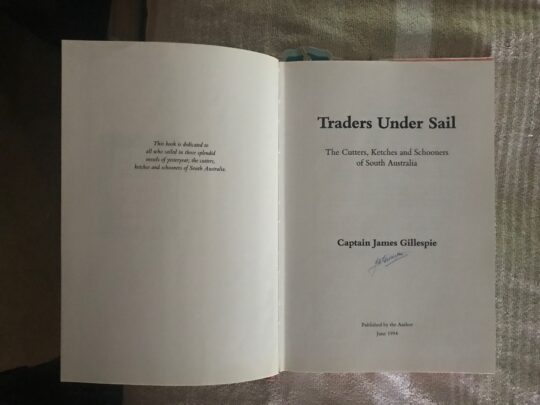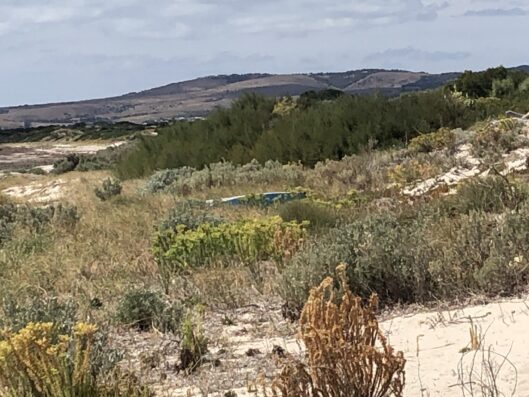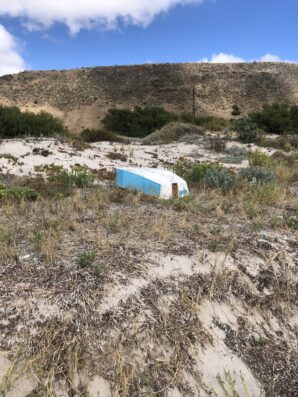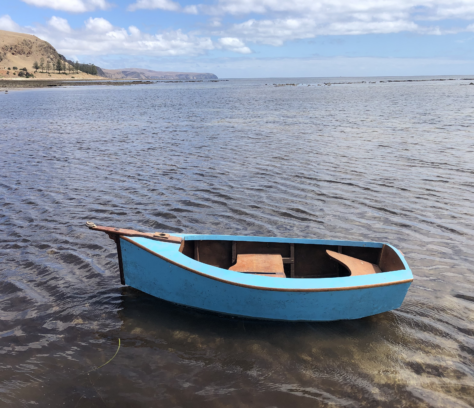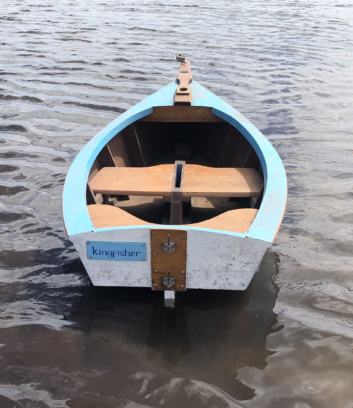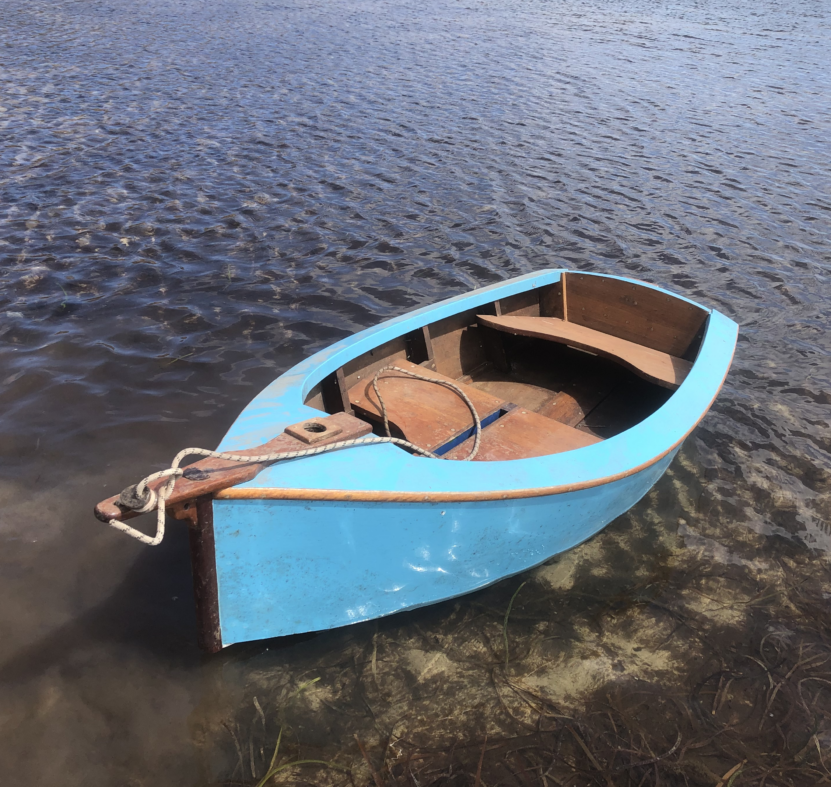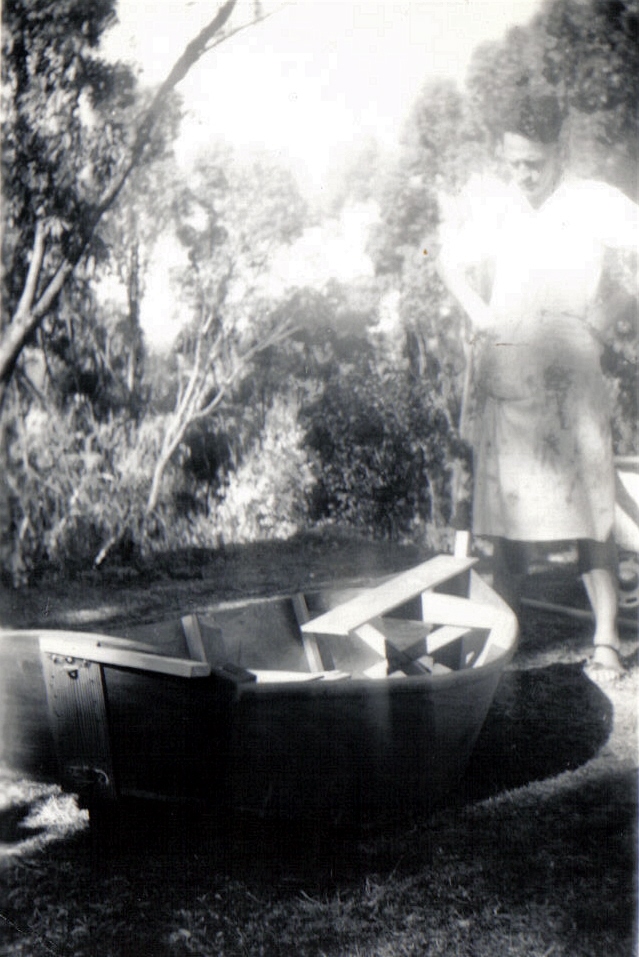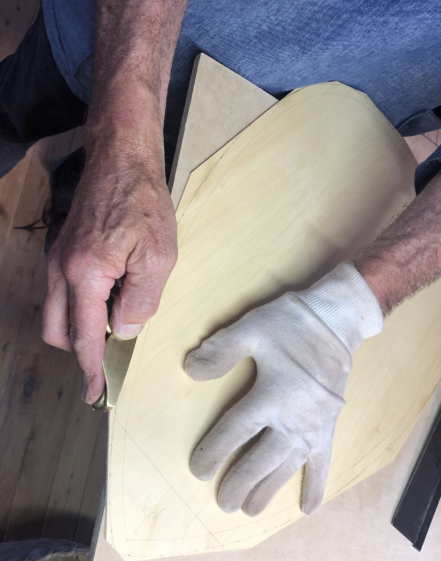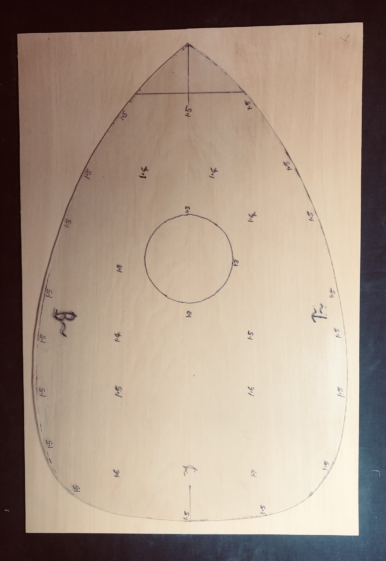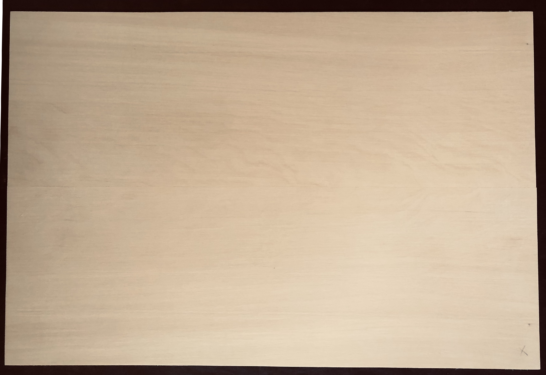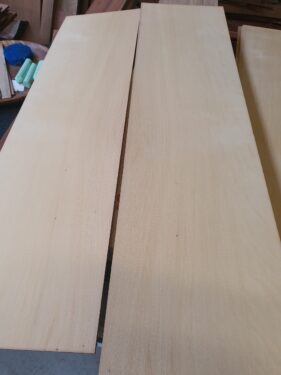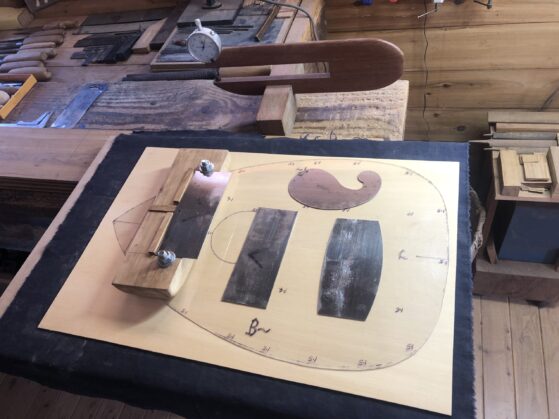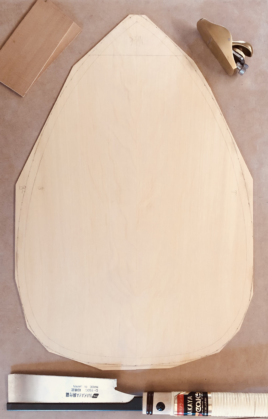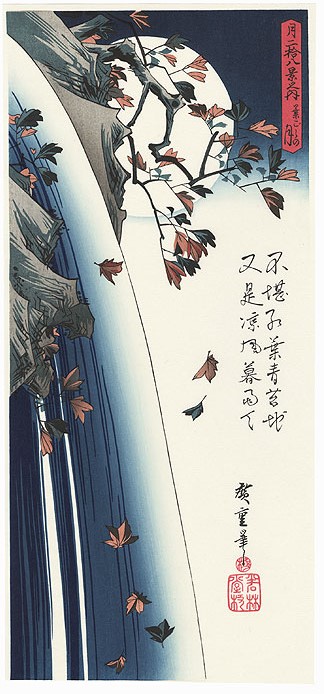I have been practicing the art of going in circles. The edge of this particular rose design is usually defined by a carved line – but I haven’t yet decided whether I will follow tradition: I quite like the look of an ‘open’ decoration. At any rate, I thought to try my hand on a spare piece of Huon Pine. The first cut is vertical; thereafter I angle the blade one way, then the other, to create a v-shaped groove. Not so easy; one false move and the game is over.
Author: Chris Wells
Reflection 5
Sea Rat to Water Rat:
There, sooner or later, the ships of all seafaring nations arrive; and there, at its destined hour, the ship of my choice will let go its anchor. I shall take my time, I shall tarry and bide, till at last the right one lies waiting for me, warped out into midstream, loaded low, her bowsprit pointing down harbour. I shall slip on board, by boat or along hawser; and then one morning I shall wake to the song and tramp of the sailors, the clink of the capstan, and the rattle of the anchor-chain coming merrily in. We shall break out the jib and the foresail, the white houses on the harbour side will glide slowly past us as she gathers steering-way, and the voyage will have begun! As she forges towards the headland she will clothe herself with canvas; and then, once outside, the sounding slap of great green seas as she heels to the wind, pointing South!
And you, you will come too, young brother; for the days pass, and never return, and the South still waits for you. Take the Adventure, heed the call, now ere the irrevocable moment passes! ‘Tis but a banging of the door behind you, a blithesome step forward, and you are out of the old life and into the new! Then some day, some day long hence, jog home here if you will, when the cup has been drained and the play has been played, and sit down by your quiet river with a store of goodly memories for company. You can easily overtake me on the road, for you are young, and I am aging and go softly. I will linger, and look back; and at last I will surely see you coming, eager and light- hearted, with all the South in your face!
From: Wind in the Willows: by Kenneth Grahame
Offcuts 3
Captain Tom Spaulding
Back in December 2020, (my brother) Jonny and his family gave me a wonderful book: Traders under Sail: The Cutters, Ketches and Schooners of South Australia.
Traders under Sail is a solid, hardback publication – and for those of you who are bibliophiles, I should add that my copy is a first edition (June 1994) in excellent condition – signed and published by the author, Captain James Gillespie.
If ever you come across a copy, be it ‘excellent’, ‘very good’, ‘good’ or ‘acceptable’, I suggest you grab it – preferably by lawful means. My own copy is a gift which (as the saying goes) keeps on giving. I read a little every day, and once I reach the end I return to the beginning – just as Dad did with his cherished copy of The Wandering Years.
Here is a random sample:
The ketch ‘Morning Star’ of 15 tons was built at Port Adelaide. Her official number was 55606 and her dimensions were L 35.4′ x B 11.0′ x D 4.8′. In 1874 she was lengthened and her new dimensions were L 47.3′ x B 11.3′ x D 4.8′ and her tonnage was increased to 17 tons.
The ‘Morning Star’ was first owned by T.Heritage. In 1876 the ownership was transferred to J.Styles; in 1885 to S.J.Bishop; in 1886 to G.Albert and R.Quin, then to Albert and Christie; in 1894 to J.D.Edwards, and in 1898 to W.Loveder who had her for about 10 years, thence to T.Young, W.Christie and J.Wallace in partnership, and finally to H.Gibbons.
This little vessel traded for over 50 years and she was well known in the trade between Port Adelaide, Port Gawler and Port Wakefield. She was wrecked at Glenelg in November, 1923.
A straightforward account, maybe – but if you take time to read between the lines, you may discover elements of romance, and even the bare bones of a novel. I’m afraid many of our coastal ketches ended their days at the bottom of the ocean. I had assumed most of them would enjoy honourable retirement – but not so. More often than not they were wrecked mid-voyage (or ‘broken up at Birkenhead’), and the long South Australian coastline is littered with sunken remains of ketches and schooners and the like. These southern waters can be treacherous at any time of year, especially duirng the winter months. A safe anchorage may suddenly become a ‘lee shore – and as far as I know, there were no weather forecasts in the days of coastal trading – save the ones based on nautical intuition and experience….
Below is a portion of log entries by Captain William Thomas, master of the trading ketch: Duchess of Kent (1880).
Nov. 15: Picking up logs etc. 16th loading barley.
Nov. 20: Picking up kedge. Sailed at 5.00 am.
Nov. 21: ‘Emu’ passed down. ‘Flinders’ passed up. Arrived Moonta, 8.30 am.
Nov. 22: 7.30 am loading copper ore, 58 tons. 12 noon hauled off to anchor.
2.00 pm under weigh. ‘Daniella’ and ‘Maldon Lewis’ passed.
Nov. 23: Splicing topmast stay. Caught a dozen Tommy Roughs.
Nov. 24: 2.00 pm off Wardang Island. 11.00 pm off Corny Point.
Nov. 26: ‘Lady Daly’ astern. Anchored Snapper Point 1.00 am
Nov.27: Pulled to Copper Coy’s wharf, discharged ore.
December 1: Sailed to dock, discharged barley
Dec. 2: Married at St. John’s Church Salisbury.
Dec. 3: Loading timber and oats etc.
Dec . 8: Cleared up. Sailed to Snapper Point. 9th cleared river 8.00 am. Beating all day. South wind. 6.30 pm stood across Gulf from Noarlunga.
Dec. 10: Althorpe 7.00 pm. Corny Point midnight.
Dec. 11: Off Wardang 5.30 am. Arrived Wallaroo 4.00 pm.
Dec. 13: Handed alongside ‘Annie Lisle’, discharged and sailed for
Port Germein at 3.30 pm.
Dec. 14: Calm. Rafted timber ashore.
Dec. 15: Discharging at jetty.
Dec. 17: Hauled vessel on beach. Discharged general and commenced
loading wheat…..
Well, I assume Captain William Thomas had a reasonably dry sense of humour. He might, in addition, have been a pragmatist: humour and pragmatism often work in tandem. I see that he is back loading timber and grain on December 3rd – and then he takes a few days break….whether as planned, or because of unfavorable winds, we will never know.
On the 8th of December he begins the return voyage to Port Adelaide – and I like to think that his newly-wed wife joined him on board. It would have been an unusual event, but not without precedent, at least in the world of the tall ships.
One example immediately springs to mind.
In December 1870, Captain Joshua Slocum, master of the Washington, 332 tons, arrived in Sydney with a general cargo – and departed in company with his wife of two or three weeks, Virginia Walker. She spent the rest of her short life on board: devoted wife and mother, counsellor, advisor, business partner – even navigator. When she died at age 34, Slocum was devastated; indeed, we are told that he never fully recovered from the tragedy.
Of course he went on to achieve great things: an astonishing adventure in the canoe, Liberdade; a voyage alone around the world in the indomitable small sloop, Spray; the subsequent writing of (surely) the greatest maritime book of all times – and his final, mysterious quest from which he never returned.
As to the mystery – I cannot help thinking Slocum’s early loss may well have had some bearing on that last voyage beyond the sunset and the baths of all the western stars – in search of whoever or whatever he was seeking.
It may be so.
But I seem to have drifted a little from our familiar gulf waters, and the sturdy trading vessels going about their business.
Returning to random samples:
Aristides, built in 1902 at Battery Point, Hobart by R. Kennedy and Son.
Official number: 104694 .
Dimensions: L 80′ x B 21.9′ X D 7.1′
Registered at Port Adelaide in 1810 by the SA government.
Purchased in 1924 by J H Murch.
Offered for sale in 1929….
At the time of the sale, Captain Tom Spaulding inspected the vessel on a slipway, and being satisfied that she was sound, and would suit his purpose of trading between Tasmanian ports and Melbourne, said that he would purchase the ship if the vendor was prepared to take the auxiliary engine out. He wanted no part of these modern inventions and preferred to rely on the power of the wind and his own skill as a sailor. The vendor was happy to comply with the conditions of sale and had the engine removed.
In this brief paragraph, our matter-of-fact author lets down his guard for a moment. We can see that he and Captain Tom Spaulding are kindred spirits. They share a love of the traditional maritime skills; a particular philosophy of time, and timing; a belief in the power and grace of the natural world; an understanding of the otherwise hidden calligraphy of tides and currents; a (prescient) faith in the practicalities and potential of wood, wind and ocean.
Yes, on the basis of those few lines, I could write a book about Captain Tom Spaulding. And I feel sure that Dad,too, would have warmed to his practical philosopy; he had faith in the old ways and means – the old philosophies. He firmly believed that coastal trading, for example, would eventually return to our southern shores. Indeed, his four sons inherited the same conviction – or you might say, dream – whichever the case may be.
In my view, traders under sail will sooner or later be revived, of necessity. I am not talking about those contemporary vessels with rotating, metal ‘sails’ operated by computer. They scarcely fall into the category of sailing boats: in their case, beauty has been overlooked in a single-minded pursuit of efficiency. But it need not be so. The old coastal traders combined beauty and function – wood and canvas – in full measure. And of course, the wind is free: it keeps on giving.
Small is beautiful….
Kingfisher is a replica of Dad’s original Silver Mist (built in the late 1950’s). Sam and I took her down to the bay this afternoon, to see what’s what. She is now secured above high water mark, awaiting a new generation of mariners.
Perhaps ‘weight’ and ‘substance’ go some way to explaining a subtle difference between the original vessel and her replica. Bowsprit (and polish) aside, my boat looks much the same as the ‘Silver Mist’ of our photograph; and yet – so it seems to me – there is not the same sense of solid integrity. ‘Silver Mist’, we could say, was a working boat born of vision and circumstance; and my own creation, a simple pleasure craft….
From Silver Mist and Beyond: My Father as Mariner
In the making…
Reflection 4
Every generation of mankind inherits the fulness of the earth: the glorious diversity of the creation which is today called ‘the environment’.
It is well that I should speak of ‘the fulness’ and ‘the environment’ – not ‘our fulness’ or ‘our environment’ – because what the great preponderance of nations do not (or will not) recognize is that although we belong to the earth, and are part of all things that are in, on or over it – it does not, and they do not belong to us.
Although we have been at liberty to enjoy what we are part of, we must not do so as tyrants or marauders, but as both grateful beneficiaries and trustees. We must discharge our responsibility to future generations by safe-guarding the land, the sea and the air, and all creatures who abide in each.
We may explore, but not devastate; discard, but neither poison nor waste; dig or mine, but neither destroy nor throw into ruin; farm or hunt, but not with mindless greed or so as to endanger what remains; manufacture, but not contaminate or fail to renew resources; build, but neither overwhelm nor distort. We must use reverently, and not squander, infect, or annihilate.
Amidst peoples’ and nations’ scramble for power, for riches, or for futile diversions and entertainment, more than a word or two of exhortation is needed to induce us to turn our gaze, our thought, and our exertions to the glories of creation which – so long as they are conserved – yield joy, rest and inspiration.
But it is not the mouthings of officialdom, the stridencies of orators, or the sterile repetition of television appeals that will persuade us to leave our daily and arid round of duties and concerns.
It is the poets, the artists, the composers and the craftsmen who, by striving for beauty and to share their glimpse of eternal verities, may entice us to pause – be it only for a few heartbeats of time – to perceive anew, and to wonder at, what the part of the world in which we live is offering us.
Andrew Wells
Opening address: Spirit of Place
Yankalilla 1993
Soundboard 6
I have finally glued the two halves of the soundboard edgewise, meanwhile offering up – as Dad used to say – a wee little bitty prayer. The aim is to create a seamless seam, which is impossible: the seamless seam in the photos is the best I can do, for now, and in certain lights looks to be entirely acceptable.
Other lights, of course, paint a different picture – but I can always invoke my default philosophy: celebrate the imperfections, as inspired by traditional Wabi Sabi.
My next task is to shape the soundboard, and thereafter plane/scrape the thicknesses down to those measurements indicated on the perspex template. It’s going to be an interesting exercise; I have an idea I am headed for yet another ‘learning curve’….
Reflection 3
Apocropha: Ecclesiasticus 38
The wisdom of a learned man cometh by opportunity of leisure: and he that hath little business shall become wise. How can he get wisdom that holdeth the plow, and that glorieth in the goad, that driveth oxen, and is occupied in their labours, and whose talk is of bullocks? He giveth his mind to make furrows; and is diligent to give the kine fodder. So every carpenter and workmaster, that laboureth night and day; and they that cut and grave seals, and are diligent to make great variety, and give themselves to counterfeit imagery, and watch to finish a work: the smith also sitting by the anvil, and considering the iron work, the vapour of the fire wasteth his flesh, and he fighteth with the heat of the furnace: the noise of the hammer and the anvil is ever in his ears, and his eyes look still upon the pattern of the thing that he maketh; he setteth his mind to finish his work, and watcheth to polish it perfectly: so doth the potter sitting at his work, and turning the wheel about with his feet, who is always carefully set at his work, and maketh all his work by number; he fashioneth the clay with his arm, and boweth down his strength before his feet; he applieth himself to lead it over; and he is diligent to make clean the furnace: all these trust to their hands: and every one is wise in his work. Without these cannot a city be inhabited: and they shall not dwell where they will, nor go up and down; they shall not be sought for in public counsel, nor sit high in the congregation: they shall not sit on the judge’s seat, nor understand the sentence of judgement: they cannot declare justice and judgement; and they shall not be found where parables are spoken. But they shall strengthen the state of the world, and their prayer shall be in the work of their craft.
